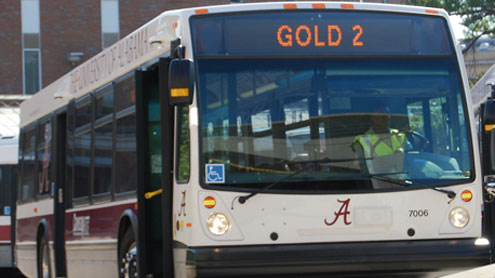Bus routes to change back after student confusion

September 10, 2020
With the outbreak of COVID-19, there has been a wide scope of changes made to campus life: students are required to wear masks, many classes have been online and the Crimson Ride, the UA bus system, has dramatically reduced the capacity of each bus.
Caroline Lewis, a senior majoring in accounting is a commuter. This is not her first year commuting; she typically purchases the Southeast Commuter parking pass, but after speaking with an employee at the Bus Hub, she was advised to purchase the Northeast Commuter parking pass for better accessibility.
Lewis used PassioGo, the app for tracking bus locations and arrival times, on her first day of class and waited for a bus to pick her up and take her to North Lawn Hall. After waiting for a considerable amount of time she decided to walk. Her Apple Watch counted that she walked 7.2 miles that day.
“I thought I was about to pass out, it was so hot,” Lewis said. “I have asthma, so whenever I was walking with my mask on I had to pull out my inhaler because I could not catch my breath. It was terrible.”
The number of buses did not change, but because of social distancing guidelines, buses could not hold as many students. The buses’ main goal had been to move students from residential halls and the commuter lot to Gorgas Library, according to UA’s Associate Director of Transportation, James Knickrehm.
According to the Crimson Ride website, passengers could request to be let off at a specific place, but when Lewis asked a driver, they said they were not allowed to stop.
“I know everybody’s doing their best, but it is very frustrating to pay $350 for a parking pass and then to be walking 7.2 miles when you were under the impression that there was going to be a bus to take you at least close to where you needed to go,” Lewis said.
Lewis called the Bus Hub on the second day of classes asking if there were any buses that would take her where she needed to go. The employee told her she would have to walk.
“We’re flexible, and right now we haven’t had any feedback from any of our students about challenges of where the buses are picking up at or where they’re going,” Knickrehm said. “We’re trying to meet the needs of students [and] getting [them] around campus.”
To ensure each bus had a maximum occupancy of 15 riders, each bus was only allowed to have two stops. Knickrehm tried to accommodate students who had shown up to the Bus Hub and did not know about those changes, such as using a 348-RIDE van to shuttle students when needed.
“I feel like they should at least update the app to show that these buses [with color-coded routes] are not running due to COVID,” Lewis said. “If that would have been the case, then I would not have gotten a parking pass where I did.”
The University did not announce the changes to the bus system until Aug. 24, five days after classes had started. Initially, Knickrehm stated that multiple stops for one bus route would not be easily accommodated, but after evaluating the effectiveness of the new routes, the University is reverting back to the original color-coded routes on Sept. 14.
Social distancing guidelines will still be enforced and capacity will be set at 15 riders. If the bus is already at capacity, the student will have to wait for the next bus to stop.







